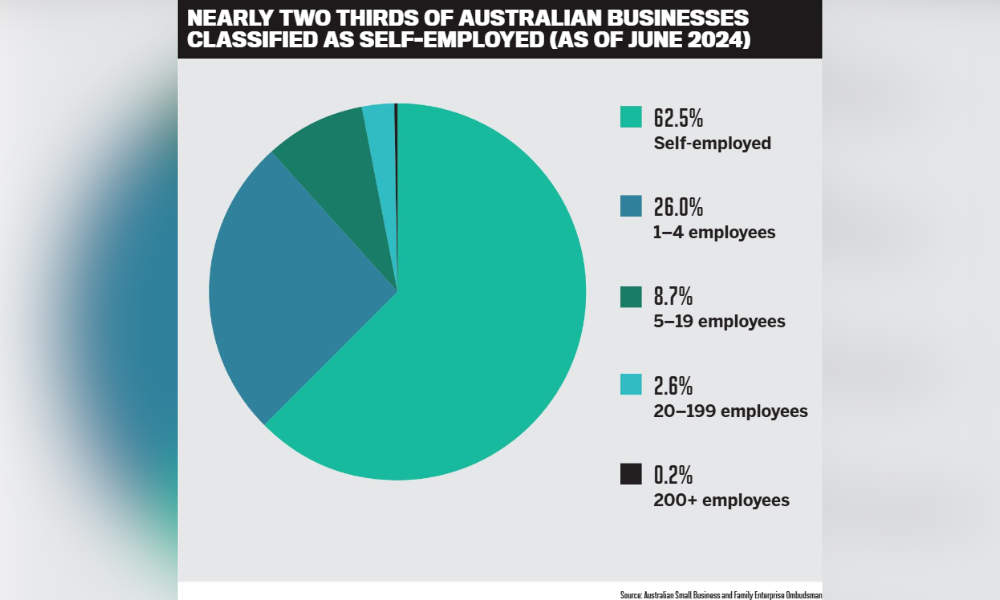The need for alt-doc lending has never been greater for Australia's entrepreneurs. Non-bank lenders are here to seize the moment

In a lending landscape where traditional income documentation can often shut the door on capable borrowers, alt-doc lending remains a vital funding pipeline for gig workers, entrepreneurs, the self-employed and other Australians with non-traditional income streams.
With demand on the rise, non-bank lenders like Pepper Money, Liberty, Resimac and Bluestone Home Loans are doubling down on their offerings, not only as a product category but as a key differentiator in a competitive market.
MPA caught up with the biggest players in the alt-doc scene to hear about the latest developments.
A key differentiator
Around a third of Pepper Money’s customers use alt-doc loan options, making them a significant part of the non-bank lender’s loan book.
“Alt-doc lending isn’t just something we offer – it’s a core part of how we help more Aussies to succeed,” said Pepper Money’s general manager, mortgages and commercial lending, Barry Saoud (pictured, below). “It’s a clear reflection of our commitment to helping more people succeed by offering helpful, real-life lending options that meet customers where they are.”

Saoud expects alt-doc demand to remain steady in a falling rates environment – or potentially grow. He said, “Rate cuts often stimulate borrower activity, including refinancing, business investment and expansion, which are common drivers among self-employed applicants. Many self-employed and non-standard income customers still face documentation challenges, regardless of rate movements.”
The story is similar at non-bank lender Liberty, where chief distribution officer David Smith (pictured, below) told MPA, “As interest rates fall, we’re seeing growing demand from borrowers seeking flexible lending solutions. Alt-doc products allow us to support a diverse range of borrowers as they navigate changing market conditions – particularly the self-employed and those with irregular income.”

Alt-doc lending is also a vital part of Resimac’s home loan offering. “It not only represents a growing segment of our loan book but also reinforces a point of difference in a highly competitive market,” said John Athanas, the non-bank lender’s general manager, sales and distribution.
Having competitive alt-doc products and policies allows Resimac to support a wider range of customers, particularly self-employed individuals and those with more complex financial situations who may not meet the criteria of traditional lenders.
“This capability is particularly effective when partnering with our brokers, whose expertise and understanding of these clients help us deliver smart solutions that truly meet their needs,” Athanas said.
Clearly, alt-doc lending is a killer app for non-bank lenders, helping them carve out a piece of the lending market despite being up against the might of the majors. But the fundamental purpose of alt-doc lending shouldn’t be forgotten – helping borrowers who are unable to secure funding from those very major banks that dominate Australia’s financial markets.
Tony MacRae, chief commercial officer at non-bank lender Bluestone, gave an example that perfectly encapsulated this fact.
“One of our brokers recently brought us a great case – a former nurse who’d taken the leap to start her own catering business,” MacRae said in a conversation with MPA. “In less than a year, she was running a successful operation, but when she went to her bank to apply for a home loan, the door was firmly shut. Why? Because she didn’t have two years’ worth of tax returns.”
Rather than turning her away, Bluestone assessed six months of business activity statements (BAS), and “with a solid view of her growing business, we were able to verify her income and understand her position”, said MacRae. “Thanks to our flexible approach, she got the green light on her home loan and the keys to her new apartment.”
Evolution and transformation
Resimac is “continuously evolving our alt-doc offering to meet borrower expectations and market needs”, said Athanas. This includes using technology to streamline the end-to-end process and enhance the broker and customer experience.
“We also engage regularly with our broker network to ensure that our product suite continues to meet the needs of their clients and remains among the most competitive in the market,” he added.
To offer more flexibility, Pepper Money recently increased its maximum loan amount to $2.5 million on prime and $3 million on near prime products, provided the applicant provides an accountant’s letter.
Read more: Pepper Money unveils digital alt doc tool
The group has also launched a fully digital workflow “that transforms how brokers, customers and accountants manage self-employed financial declarations and accountant letter documentation”, said Saoud.
He added, “This is more than just a tech upgrade – it’s a game changer for the self-employed segment. By digitising a historically manual process, we’re giving brokers greater control, improving turnaround times and enhancing the overall experience for all parties involved.”
Liberty recently updated its tax debt consolidation options for low-doc borrowers and strengthened its serviceability assessments to help even more customers on alternative income streams.
This came in handy when Liberty recently assisted a self-employed applicant with a rapidly growing business who was “juggling a home renovation loan and a business loan, among other debts, and finding it hard to keep up with repayments”, explained Smith.
By assessing BAS statements and recognising an upward trend in earnings, Liberty helped the client consolidate debts for better cash flow management.
“Scenarios like these are not uncommon for Liberty,” said Smith. “We offer brokers hands-on support, including access to our skilled team and specialised training to help them confidently navigate complex deals and find a solution that fits.”
In addition, Liberty has released a suite of updates across its home loan products to further support homebuyers with their borrowing capacity. These include 40-year loan terms and increased loan limits for full- and low-doc products.
Read more: The unwavering resilience of SMEs
Bluestone is also evaluating its product suite “to ensure it aligns with the evolving needs of our customers”, said MacRae.
Later this year, for instance, Bluestone intends to introduce alt-doc construction and commercial loans, “which we believe will close a gap in our offering as we strive to be the preferred broker partner for all specialised lending”.
Bluestone is also refining its originations platform to streamline the credit-decisioning process. “This is part of a broader initiative to respond to shifting borrower profiles and the growing demand for faster and more flexible lending solutions,” said MacRae.
New customer trends emerging
Every lender interviewed by MPA said the same thing: Alt-doc lending is becoming even more important for the growing cohort of self-employed Australians.
“Alt-doc lending is empowering a new wave of entrepreneurs to thrive,” said Smith. “We're seeing more freelancers, gig workers and self-employed borrowers turning to alt-doc solutions. Many of these borrowers have non-traditional income streams or experience seasonal and irregular income patterns, which could make accessing finance through the major banks more challenging.”
Saoud is seeing more younger entrepreneurs and gig-economy workers turning to alt-doc loans, alongside a rise in borrowers with unique financial structures needing alternative ways to prove serviceability.
“As awareness of alt-doc lending grows, more borrowers are proactively seeking these solutions – not just as a last resort but as a preferred option that better reflects their financial reality,” he said.
For example, Pepper Money recently supported a self-employed couple facing a cash flow crunch after a surprise tax bill. Six years into running their own childcare business, the pair had seen steady income growth – but a $150,000 tax debt was creating serious financial pressure.
“They had no adverse credit and a solid repayment history, but the ATO debt meant their monthly commitments were becoming unmanageable,” said Saoud.
The couple’s property was valued at $2.5 million, with a $1.5 million home loan. Their goal was to refinance to $1.65 million to consolidate debt and regain control of their finances.
Ultimately, Pepper Money’s alt-doc product allowed the couple to streamline their repayments and refocus on running their growing business. “It’s a great example of how we work with self-employed borrowers who don’t fit the traditional lending box,” said Saoud.
ATO debt is evidently a running theme in the alt-doc space.
In one of the most unique recent scenarios at Resimac, the lender worked with a client looking to refinance their owner-occupied home and release equity to purchase an investment property.

An issue occurred when the borrower’s quarterly BAS showed a higher ‘owed to ATO’ amount than previous quarters. Athanas (pictured, above) explained, “Looking into this, it was identified this spike was due to a one-off vehicle purchase made through the business.
“Working closely with the broker, we obtained the vehicle invoice and an accountant’s letter verifying the timing and one-off nature of the purchase. By isolating and excluding the GST expense related to this vehicle, we were able to accurately assess the client’s financial position and approve the higher loan amount needed to support their investment goals.”
An optimistic outlook
“We expect demand for alt-doc loans to keep growing, especially if rates fall further,” said MacRae (pictured, below). “Lower rates can bring more borrowers into the market, including those who might be refinancing or applying for the first time. But many still won’t tick every traditional box.

“As work and income patterns continue to shift, more people will need flexible options, and more brokers will be looking to lenders like Bluestone who know how to work with alt-doc scenarios.”
Saoud added, “As more Australians embrace self-employment, gig work and non-traditional income streams, the need for flexible documentation solutions will only increase.
“Technology will also play a key role, as we’re making it easier and faster to validate income and process applications. We also anticipate greater awareness and acceptance of alt-doc options among brokers and customers alike, especially as we ramp up our investment in education.”
Athanas anticipates continued growth in alt-doc lending at Resimac, “driven by evolving borrower profiles and the expanding role of brokers in identifying and securing finance solutions for these customers”.
Alt-doc lending can also help to strengthen broker relationships with key referrers like accountants, who often have long-standing connections with clients that fit the alt-doc profile. “This trusted network of support benefits all parties and positions alt-doc lending as a vital and expanding part of the mortgage landscape,” Athanas said.
At Liberty, Smith has already seen an increase in demand in the early stages of a falling rates environment. “Lower rates typically encourage borrowing, and with more Australians embracing self-employment and gig work, the need for flexible lending solutions continues to grow,” he said.

As borrower profiles continue to shift outside of the traditional mould, there is no doubt that the need for alt-doc options – which are evidently the forte of alternative lenders – is only going to increase.
This should be music to the ears for brokers seeking out fresh opportunities.



